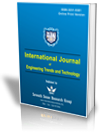Water Pipe Leakage Detection System based on Fuzzy Logic and Sensor Network
Water Pipe Leakage Detection System based on Fuzzy Logic and Sensor Network |
||
 |
 |
|
| © 2025 by IJETT Journal | ||
| Volume-73 Issue-4 |
||
| Year of Publication : 2025 | ||
| Author : A.B. Primawan |
||
| DOI : 10.14445/22315381/IJETT-V73I4P111 | ||
How to Cite?
A.B. Primawan, "Water Pipe Leakage Detection System based on Fuzzy Logic and Sensor Network," International Journal of Engineering Trends and Technology, vol. 73, no. 4, pp. .114-119, 2025. Crossref, https://doi.org/10.14445/22315381/IJETT-V73I4P111
Abstract
A water pipe leak detection system is a system needed to overcome the problem of loss of water resources in pipelines. Therefore, a leak detection system has been designed and implemented by utilizing the fuzzy logic method to determine the condition of pipe leaks based on the results of measuring water flow and soil moisture levels around the pipe location. The results obtained show that the system can measure water flow and soil moisture well, as well as make decisions about the condition of pipe leaks in a particular area. The accuracy level of the implemented detection system is 93% compared to the simulation. The proposed system combines the results of water flow and soil moisture measurements to make decisions based on fuzzy logic.
Keywords
Water pipe leakage, Fuzzy logic, Water flow sensor, Soil sensor, Wireless sensor network.
References
[1] Mohammed Rezwanul Islam et al., “An Intelligent IoT and ML-Based Water Leakage Detection System,” IEEE Access, vol. 11, pp. 123625-123649, 2023.
[CrossRef] [Google Scholar] [Publisher Link]
[2] Niamat Ullah, Zahoor Ahmed, and Jong-Myon Kim, “Pipeline Leakage Detection Using Acoustic Emission and Machine Learning Algorithms,” Sensors, vol. 23, no. 6, pp. 1-9, 2023.
[CrossRef] [Google Scholar] [Publisher Link]
[3] N.N. Che et al., “Water Pipeline Leakage Monitoring System Based on Internet of Things,” Journal of Physics: Conference Series, vol. 1962, no. 1, pp. 1-10, 2021.
[CrossRef] [Google Scholar] [Publisher Link]
[4] P. Swetha Reddy et al., “Water Leakage Detection Monitoring and Controlling System Using IOT,” International Journal of Engineering and Technology, vol. 7, no. 2.7, pp. 120-123, 2018.
[CrossRef] [Google Scholar] [Publisher Link]
[5] Raheleh Jafari et al., “Pipeline Leak Detection and Estimation Using Fuzzy PID Observer,” Electronics, vol. 11, no. 1, pp. 1-14, 2022.
[CrossRef] [Google Scholar] [Publisher Link]
[6] M. Shafiqul Islam et al., “Leakage Detection and Location in Water Distribution Systems Using a Fuzzy-Based Methodology,” Urban Water Journal, vol. 8, no. 6, pp. 351-365, 2011.
[CrossRef] [Google Scholar] [Publisher Link]
[7] Sayeesh et al., “A Review on Water Leakage Detection in Pipes using Sensors,” International Journal of Research in Engineering, Science and Management, vol. 2, no. 5, pp. 751-754, 2019.
[Google Scholar] [Publisher Link]
[8] Ahmed D. Kora et al., “Accurate Radio Coverage Assessment Methods Investigation for 3G/4G Networks,” Computer Networks, vol. 107, pp. 246-257, 2016.
[CrossRef] [Google Scholar] [Publisher Link]
[9] Mohammed Rezwanul Islam et al., “A Review on Current Technologies and Future Direction of Water Leakage Detection in Water Distribution Network,” IEEE Access, vol. 10, pp. 107177-107201, 2022.
[CrossRef] [Google Scholar] [Publisher Link]
[10] Turki Al Qahtani et al., “A Review on Water Leakage Detection Method in the Water Distribution Network,” Journal of Advanced Research in Fluid Mechanics and Thermal Sciences, vol. 68, no. 2, pp. 152-163, 2020.
[CrossRef] [Google Scholar] [Publisher Link]
[11] Wee Kee Phua et al., “Ain-Based Mems (Micro-Electro-Mechanical System) Hydrophone Sensors for IoT Water Leakage Detection System,” Water, vol. 12, no. 11, pp. 1-12, 2020.
[CrossRef] [Google Scholar] [Publisher Link]
[12] Muhammad Haziq Hakim Rosman et al., “Real-Time Underground Plastic Pipeline Water Leakage Detection and Monitoring System,” International Journal of Robotics and Control Systems, vol. 2, no. 2, pp. 424-434, 2022.
[CrossRef] [Google Scholar] [Publisher Link]
[13] Zhiyuan Chen, Maryam Temitayo, and Dino Isa, “Pipe Flaws Detection by Using the Mindstorm Robot,” International Journal of Engineering Research and Applications, vol. 2, no. 6, pp. 569-574, 2012.
[Google Scholar] [Publisher Link]
[14] Marian Kwietniewski, Piotr Świercz, and Jarosław Chudzicki, “Modern Methods for Monitoring Water Leakages in Water Networks,” Studia Geotechnica and Mechanica, vol. 44, no. 1, pp. 53-65, 2022.
[CrossRef] [Google Scholar] [Publisher Link]
[15] Hani mohammed moqbel saleh, and Abdelrasoul Jabar Alzubaidi, “Petrol Pipe Line Telemonitoring Design,” International Journal of Engineering Research and Applications, vol. 5, no. 3, pp. 39-43, 2015.
[Publisher Link]
[16] Birendra Pratap, “Detection of Water Leakage Paths Using Self-Potential and Geoelectrical Resistivity Methods: A Case Study of Kailana Lake-Takht Sagar in the Jodhpur City, Rajasthan, India,” HydroResearch, vol. 3, pp.166-174, 2020.
[CrossRef] [Google Scholar] [Publisher Link]
[17] Xuan Hu et al., “Novel Leakage Detection and Water Loss Management of Urban Water Supply Network Using Multiscale Neural Networks,” Journal of Cleaner Production, vol. 278, 2021.
[CrossRef] [Google Scholar] [Publisher Link]
[18] Diego Perdigão Sousa et al., “Leakage Detection in Water Distribution Networks Using Machine-Learning Strategies,” Water Supply, vol. 23, no. 3, pp. 1115-1126, 2023.
[CrossRef] [Google Scholar] [Publisher Link]

